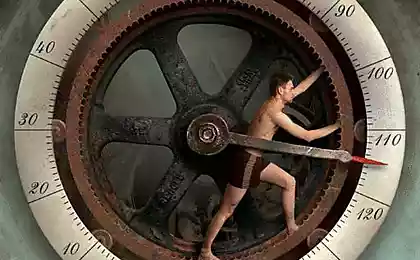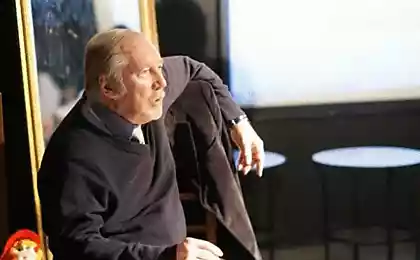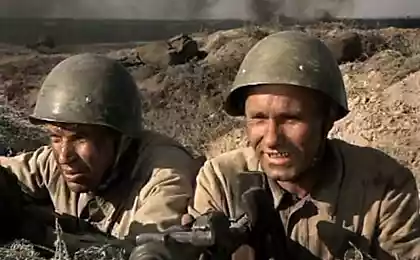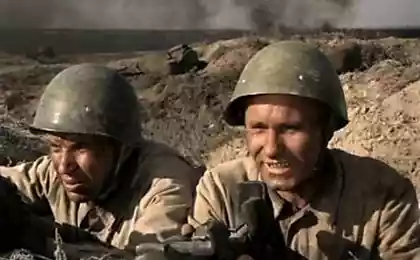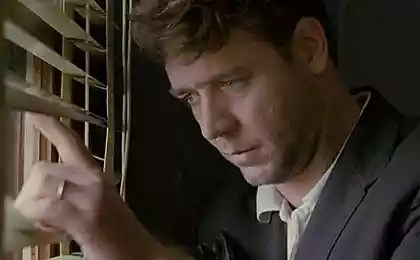583
How to help humanity after death
Sixty seven million four hundred sixty seven thousand three hundred sixty two
© Marc Quin
A well-known journalist Mary roach, in 2003, published a book called "Cadaver. As the body after death is science", translated last year on the Russian. The book quickly gained status as the most unusual non-fikshn. Talking about the dissection and the anatomical theater, roach reveals the essence of the relationship of people, doctors and criminologists to the dead body and tells about the history of the question of the ethics of dissection and autopsy. Why not throw the head of the deceased, how can a dead man be behind the wheel or even in the army, what gives the corpse sacred properties and how to find out if you do or already dead, — of all this Mary roach says, not without irony and unashamedly own experience. T&P chose the most interesting theses.
What to do after death

"It seems to me that the state of the dead resembles the human condition in a cruise voyage. Most of the time you spend lying on your back. The brain is disabled. The body softens. Nothing new happens, and you don't expect anything. Why just lie on your back, if you can make something interesting and new, something useful?"
What happens to a person after death? This question has many answers given by theologians, philosophers and esoteric. But have we reflected on what a dead man — not only a construct of memories, transcendent hopes and views about the afterlife? The material shell of a man remains in this world — even if briefly — and participates in its change for the better. Not only medicine uses the bodies, although this image is familiar to us as ancient pictures, and on existing and still anatomical theatres and the stories of first-year students of medical universities. Of course, in this area the use of corpses for the benefit of mankind is the most important. Heart transplant, sex change, cosmetic changes — all of these operations would be impossible if surgeons have not practiced their techniques on dead bodies. However, cadavers have helped and other areas of scientific knowledge: participated in testing the first guillotine and automotive crash tests, have made space travel and even suffered crucifixion with the aim of establishing the authenticity of the shroud of Turin.
The problem of ethics and depersonification

"Is dying, the people of southern California, have bequeathed their bodies to science just to get his end away as the object for training the techniques of plastic surgery of the nose? Is it good that they did not know that their bodies will be then? Or their bodies acquired fraudulently?"
After people learn about the great mission of the corpses, they immediately begin to ask questions of ethics. Really, how ethical to use cadavers lived until recently, people who have relatives and friends? Should start with the fact that the bodies volunteer their hosts: in the name of science and for the salvation of the living. The people who give their bodies to medicine, is rarely interested in how their bodies will be used. However, not all relatives inquired what will be done with the body of the deceased, if they did, then most likely immediately be filed in the court. And if they the donors of the bodies has heard detailed information about what happens to them after death, hardly would agree to it. Body shot from the weapon, in order to check out new ammunition, divided into parts for medical research put it in the trunk of a car and pour concrete for forensic experiments. Even many working in the field of medicine people would not want to bequeath his body for the benefit of science: according to roach, the doctors who have seen disrespect to the corpses, unwilling to be in the same situation. However you need to remember that for centuries the ethical question about the use of corpses was considered all the more carefully and planned progress. Despite the fact that the relatives not to report that will, for example, to shoot a gun the head of their late father, at present there is a ban on photographing the faces of the dead patients. Because they can not defend their rights, pictures of bodies in books on pathological anatomy, or forensics are printed with a black stripe closed eyes.
How to build a relationship with a corpse? Be limited to are Wittgenstein's words: whether in silence or to engage in beketovskaya absurd dialogue?
"People say that death is nothing funny. But it is not! Being dead is absurd. This is the most stupid situation in which each of us is. Hands and feet do not obey. Mouth open. To be dead — ugly, disgusting and ashamed, and with it, damn it, nothing can be done!"
But what if you look at an ethical problem from the other side? Hundreds of occupations are associated with corpses, and if I want to rest people or not, the professionals have to interact with the dead. How to build a relationship with a corpse? Be limited to are Wittgenstein's words: whether in silence or to engage in beketovskaya absurd dialogue? "Cadaver" refers to the students entering into complex relationships with a dead body full of respect and reverence: "When we cut the body, I patted the arm of the corpse, saying "all is well". Feelings in relation to the body, though inanimate, it is hard to discard. It's especially difficult to do for those who are just beginning to work with the dissection of corpses. One of the students told roach that once finished the course, I began to miss "his" corpse, and he even felt sad when in the course of operations of the whole body was just a small part.
How do people struggle with the identification of the dead body with a living, aware that it is impossible to treat the dead the same as a living person, despite the fact that outwardly they seem the same? Decapitator, trained cutting heads and working, for example, in the offices of plastic surgery share their experiences: "Those who have to constantly deal with human bodies, it is easier to think of them as objects and not as people". To help people to get used to the silence of corpses and to depersonalise the dead body, the bodies are first wrapped with gauze, so they are not perceived as something whole and from having any involvement in the man. To learn how to take the corpses out of those emotional and intellectual ties that were lying on the table of the physician during life, is one of the main objectives for medical students and young doctors. The ability to depersonalization will help them to maintain composure and overcome yourself in an emergency situation in which the most important is to save the life of a man, and not to give vent to emotions. Perhaps because of such suspension of emotions in relation to the patient's doctors seem to patients is extremely cold and rational.
The history of preparation
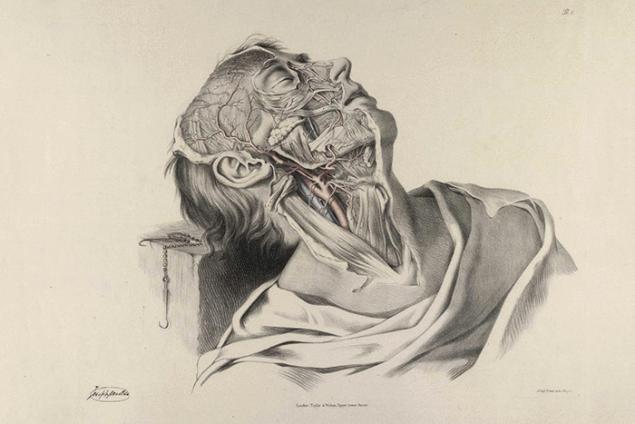
Now, when at the disposal of medicine there are thousands voluntarily given each week of the corpses, it's hard to think about what a problem it was previously. Roach looks at the history of dissection, starting from the IV century BC, when Alexandrian king Ptolemy I was allowed to open the corpses for further study. Even the king himself was engaged in the dissection of bodies. However, not all doctors were so moderate in their zeal to advance the science of Roman doctor Gerofi went on Egyptian surgeons and at some point was even alive to dissect criminals alive exposing their monstrous vivisection, what he was accused of Tertullian.
"The monstrous house-a crypt filled with parts of the limbs, the grinning heads and opened skulls under the feet of the blood marsh, and the monstrous spirit which comes from all of this, flocks of sparrows fighting for pieces of lung, the rats in the corner eating bleeding inside".
The next ethical problem in the history of the preparation was the lack of corpses for anatomical schools, which are in abundance appeared in XVIII–XIX centuries in England and Scotland. The bodies in schools by law must come only after the executions, and the common people refused to sacrifice their bodies, as they believed in the second coming and resurrection from the grave in flesh and blood. Anatomists were allowed to use bodies of criminals more from the desire to further punish those than out of a desire to help science. For example, in early US history there are references to the punishment of duelists: "the category of criminals, subjected to dissection after execution, said duelists, because the death penalty was too light a punishment for those who were willing to die at the hands of the enemy." And in Britain in the XVIII century introduced the dissection instead of quartering. Thus, anatomists were for ordinary citizens someone like executioners.
"In the anatomical laboratories of the XVIII and XIX centuries that depicted Thomas Rowlandson and William Hogarth, the guts of the corpses hanging from the tables, as the ribbon in the parade, skull Bouncing in the boiling pot, the entrails scattered on the floor where they eat dogs. Around the crowd of people who are aware of the evil and carnivorous expression on their face."
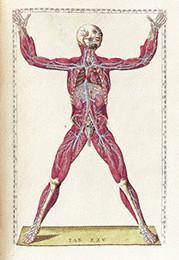
As medicine moved forward and corpses for research were scarce in Paris was allowed to dissect the bodies of the poor who died in hospitals of the city. In England such a law was not, and doctors had to either go to France or to secretly steal the bodies of their relatives and to dissect them right before the funeral. "About the surgeon and anatomist of the seventeenth century William Harvey, who is known in connection with the discovery of the circulatory system, said that he is so passionate that he is able to dissect his own father or sister." Of course, most anatomists did not hesitate to borrow and the bodies of other people. The doctors came by night to the cemetery and tore up fresh graves in search of well-preserved corpses. Since technically the offense was only plundering the grave, and the doctors did not take from it anything but, in fact, the body, the anatomists long enough was able with impunity to hunt for corpses. Many teachers of medicine in Scotland even encouraged such activities with their students, many of whom paid no tuition cash but dead bodies. Often digging bodies engaged even well-known professors: "Thomas Sewell, who was personal physician to three U.S. presidents and founded the institution now known as the medical faculty of George Washington University, in 1818, was accused of digging up the corpse of a young woman with the purpose of preparation".
"One anatomist unexpectedly delivered to the laboratory the package instead of the corpse found a lovely ham, cheese, a basket of eggs and a huge ball of yarn. You can imagine the extreme, and extremely unpleasant surprise who is expected ham, cheese, eggs and yarn in the package is well Packed but quite dead Englishman."
"Anatomy season" lasted in London from the early XIX century from October to may, and at this time many doctors hired by the people, the so-called voskresitelya, dug up hundreds of corpses. Income for such hard work was very high — about $ 1,000 per year, i.e. ten times more than ordinary wages of the worker. Such work could also be associated with the crimes — known case of a doctor from Edinburgh, Robert Knox, who once paid a significant sum of money to two strangers for providing by chance they found the corpse. After those crooks realized that selling corpses can make good money, they decided to produce their own, and then killed many hobos, selling their bodies to the doctors.
It is worth noting that, despite the promotion of preparation in Egypt and Europe, some cultures had long-standing ban on the opening of dead bodies: for example, in China it was considered a desecration and was banned, and Roman Empire prohibitions on dissection to blame for the fact that medicine has gone down the wrong path. The great Galen, considered the father of medicine, never alone does not dissect the man, but only sewed up the wound and butchered animal carcasses. "He did a lot right but a lot wrong. In his paintings of the liver had five lobes, and the heart — three ventricle". The Greek Hippocrates, incidentally, also never dissected a human corpse and called tendons, nerves, and the brain was considered a gland, which produces mucus.
Anatomical crimes of modern times
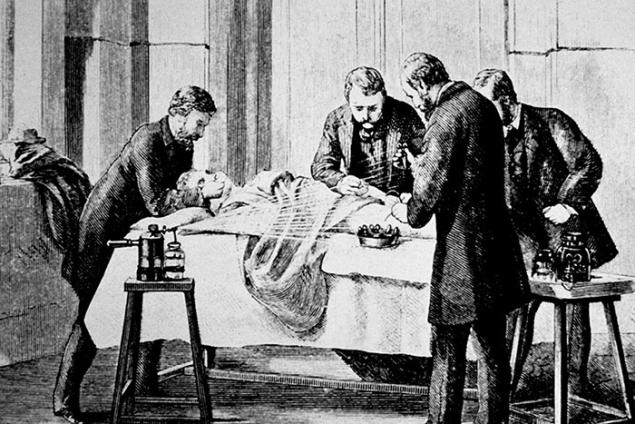
In the nineteenth century, there was a special operating theatres onlookers crowded around them in anticipation of perceptions, and doctors demonstrated their art to the public. "It was an incredible noise, with galleries and with the upper ranks was heard cries of "Take off your hat!", "Keep your head down!" Those who were richer, sought to avoid a similar fate, because patients operated on without the usual today anesthesia. The first operation with anesthetic ether was carried out only in 1846, up to the time patients cut, sewed and cut without any anesthesia. As a painful shock and uncontrolled movements could lead to failure of the entire operation of the operated tied to the table. Patients in public shyly covered nakedness with clothes, from this we see in the paintings of the XIX century, so many dressed patients.
Besides the fact that the ancient surgeons were not experienced by physicians and performed almost cirulnick duties — pulled teeth and let blood, their operations were, moreover, mostly experimental, and the benefit to the patient if expected, it was of minor importance. After the anesthesia, the patients have less to suffer from the pain, but the lack of legal control over the procedure of anesthesia has led to the fact that some manipulation could only be performed by doctors without the consent of the clients. One time was common practice of removing the Appendix of patients not suffering from appendicitis, but lying under anesthesia. Similar training for students who had not yet prosecuted under the law, was quite ordinary. Today all procedures performed on patients under anesthesia are strictly monitored, and if necessary, to conduct training in use, or dead bodies, or specially invited people.
The skeleton in the closet CSI
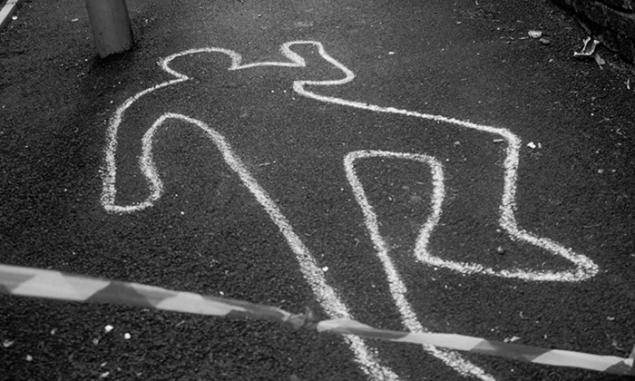
"Behind the medical faculty of the University of Tennessee there is a wonderful wood, where the branches of the trees, squirrels jumping, birds sing and people lie on the green grass in the sun and sometimes in shade, depending on where they put researchers. This cute hilly slope of the Knoxville — the world's only field of research devoted to the study of the decay of human bodies".
Without the study of corpses, the forensics would not be able to accurately record the time of death to determine its cause. Among ordinary people, quite little is known about what rigor Mortis is not an exact factor, since terminated after 10-48 hours after death. To determine time of death in corpses that are more than three days, followed by forensic entomological markers, determining the age of fly larvae, to assess the stage of decay of the flesh, take into account the weather conditions and the state of the environment. "In order to establish the influence of all these factors, scientists buried the bodies in shallow graves, poured concrete, leave them in the trunks of cars, is lowered into the ponds and tied in plastic bags. In short, researchers have to do with dead bodies is almost all that can come up with the murderer to hide the body".
The work of forensic scientists who study the corpses, and sent to them with the assistance of volunteers, reminiscent of Buddhist yogis, who was eyeing different stages of decomposition of the body for meditation and humility before death. Like them, criminologists and medical researchers are taught to accept and not to fear the worst bodily manifestations of death, to overcome aversion and disgust.
Dead behind the wheel
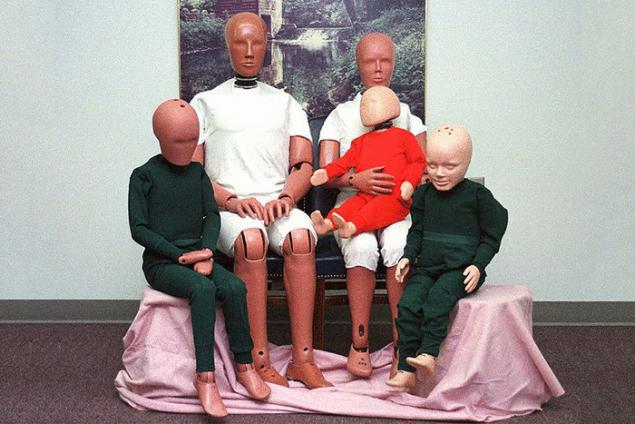
Today one of the most promising application fields of corpses are the projects on the modeling of crashes, or crash tests. It dead mankind owes relatively safe at the moment car: practical previously, any accident could be fatal.
"Knowing what kind of load can bear human skull, spine, or humerus, allows car manufacturers to build a machine, which, as they hope, this impact force will not be achieved".
In crash tests most often used mannequins that we can often observe in various popular science programs. However, human corpses is the most optimal material for the real assessment of strength, for example, thorax or larynx. Until the 1920-ies cars "Ford" were issued without the windshield, that's why people wore special glasses, like aviators. After started to produce the cars with glass, which, however, wounded the driver in the accident — often fatal. The manufacturers then tried to use tempered glass, but it, unfortunately, though not broken, but could cause serious injury to the driver when hitting it. It is the use in tests of dead bodies helped to develop the modern windshield: the corpse was attached to the glass and dropped from different heights, testing after the skull to the presence of hairline cracks. Thus it was constructed of special glass thickness, in order not to provoke the concussion at impact and keep the driver inside the car during the collision: "in a frontal collision into a wall at a speed of 45 km/h seat belt warning the driver will be able to get out of the car without serious injury, only complaining of injuries and his inability to drive a car".
Thanks to dead bodies, involved in crash testing, car manufacturers abandoned the threat of tail structures, which previously could impale the driver in the accident, and developed adapted to a real person, not mannequin, airbag: "Every body involved in the testing three-point seat belts, each year saves the lives of 61 people. Every body experiencing, airbag annually saves the life of 147 people in car accidents, without which these devices would be fatal. For every corpse whose head was smashed on the windshield, each year saves the lives of 68 people".
The cadaver in the army
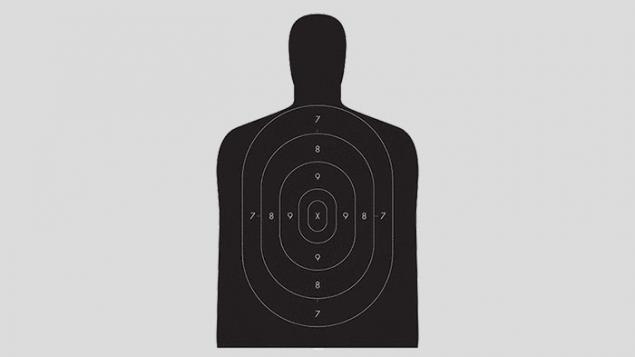
The corpses are sent for medical experiments, do not always serve to the salvation of man in a hospital bed. Sometimes the dead use for the other, not less humane things: testing ammunition. In the French army since the beginning of the XIX century practiced "shooting dead bodies with the purpose of the study the results of the shots in military terms". The US army has made similar experiments — shot human corpses from various distances in order to create a more humane weapon. The fact that the purpose of war is not a physical destruction of the enemy, and removing it from the system. Therefore conducted in the nineteenth century experiments were focused on the development of such bullets, which might only wound the enemy. The test results showed that the size of the bullets is necessary to reduce and make them of more refractory than lead, the material that the bullets were less deformed in the body and are not damaged thereby tissue and internal organs.
Source: theoryandpractice.ru
© Marc Quin
A well-known journalist Mary roach, in 2003, published a book called "Cadaver. As the body after death is science", translated last year on the Russian. The book quickly gained status as the most unusual non-fikshn. Talking about the dissection and the anatomical theater, roach reveals the essence of the relationship of people, doctors and criminologists to the dead body and tells about the history of the question of the ethics of dissection and autopsy. Why not throw the head of the deceased, how can a dead man be behind the wheel or even in the army, what gives the corpse sacred properties and how to find out if you do or already dead, — of all this Mary roach says, not without irony and unashamedly own experience. T&P chose the most interesting theses.
What to do after death

"It seems to me that the state of the dead resembles the human condition in a cruise voyage. Most of the time you spend lying on your back. The brain is disabled. The body softens. Nothing new happens, and you don't expect anything. Why just lie on your back, if you can make something interesting and new, something useful?"
What happens to a person after death? This question has many answers given by theologians, philosophers and esoteric. But have we reflected on what a dead man — not only a construct of memories, transcendent hopes and views about the afterlife? The material shell of a man remains in this world — even if briefly — and participates in its change for the better. Not only medicine uses the bodies, although this image is familiar to us as ancient pictures, and on existing and still anatomical theatres and the stories of first-year students of medical universities. Of course, in this area the use of corpses for the benefit of mankind is the most important. Heart transplant, sex change, cosmetic changes — all of these operations would be impossible if surgeons have not practiced their techniques on dead bodies. However, cadavers have helped and other areas of scientific knowledge: participated in testing the first guillotine and automotive crash tests, have made space travel and even suffered crucifixion with the aim of establishing the authenticity of the shroud of Turin.
The problem of ethics and depersonification

"Is dying, the people of southern California, have bequeathed their bodies to science just to get his end away as the object for training the techniques of plastic surgery of the nose? Is it good that they did not know that their bodies will be then? Or their bodies acquired fraudulently?"
After people learn about the great mission of the corpses, they immediately begin to ask questions of ethics. Really, how ethical to use cadavers lived until recently, people who have relatives and friends? Should start with the fact that the bodies volunteer their hosts: in the name of science and for the salvation of the living. The people who give their bodies to medicine, is rarely interested in how their bodies will be used. However, not all relatives inquired what will be done with the body of the deceased, if they did, then most likely immediately be filed in the court. And if they the donors of the bodies has heard detailed information about what happens to them after death, hardly would agree to it. Body shot from the weapon, in order to check out new ammunition, divided into parts for medical research put it in the trunk of a car and pour concrete for forensic experiments. Even many working in the field of medicine people would not want to bequeath his body for the benefit of science: according to roach, the doctors who have seen disrespect to the corpses, unwilling to be in the same situation. However you need to remember that for centuries the ethical question about the use of corpses was considered all the more carefully and planned progress. Despite the fact that the relatives not to report that will, for example, to shoot a gun the head of their late father, at present there is a ban on photographing the faces of the dead patients. Because they can not defend their rights, pictures of bodies in books on pathological anatomy, or forensics are printed with a black stripe closed eyes.
How to build a relationship with a corpse? Be limited to are Wittgenstein's words: whether in silence or to engage in beketovskaya absurd dialogue?
"People say that death is nothing funny. But it is not! Being dead is absurd. This is the most stupid situation in which each of us is. Hands and feet do not obey. Mouth open. To be dead — ugly, disgusting and ashamed, and with it, damn it, nothing can be done!"
But what if you look at an ethical problem from the other side? Hundreds of occupations are associated with corpses, and if I want to rest people or not, the professionals have to interact with the dead. How to build a relationship with a corpse? Be limited to are Wittgenstein's words: whether in silence or to engage in beketovskaya absurd dialogue? "Cadaver" refers to the students entering into complex relationships with a dead body full of respect and reverence: "When we cut the body, I patted the arm of the corpse, saying "all is well". Feelings in relation to the body, though inanimate, it is hard to discard. It's especially difficult to do for those who are just beginning to work with the dissection of corpses. One of the students told roach that once finished the course, I began to miss "his" corpse, and he even felt sad when in the course of operations of the whole body was just a small part.
How do people struggle with the identification of the dead body with a living, aware that it is impossible to treat the dead the same as a living person, despite the fact that outwardly they seem the same? Decapitator, trained cutting heads and working, for example, in the offices of plastic surgery share their experiences: "Those who have to constantly deal with human bodies, it is easier to think of them as objects and not as people". To help people to get used to the silence of corpses and to depersonalise the dead body, the bodies are first wrapped with gauze, so they are not perceived as something whole and from having any involvement in the man. To learn how to take the corpses out of those emotional and intellectual ties that were lying on the table of the physician during life, is one of the main objectives for medical students and young doctors. The ability to depersonalization will help them to maintain composure and overcome yourself in an emergency situation in which the most important is to save the life of a man, and not to give vent to emotions. Perhaps because of such suspension of emotions in relation to the patient's doctors seem to patients is extremely cold and rational.
The history of preparation

Now, when at the disposal of medicine there are thousands voluntarily given each week of the corpses, it's hard to think about what a problem it was previously. Roach looks at the history of dissection, starting from the IV century BC, when Alexandrian king Ptolemy I was allowed to open the corpses for further study. Even the king himself was engaged in the dissection of bodies. However, not all doctors were so moderate in their zeal to advance the science of Roman doctor Gerofi went on Egyptian surgeons and at some point was even alive to dissect criminals alive exposing their monstrous vivisection, what he was accused of Tertullian.
"The monstrous house-a crypt filled with parts of the limbs, the grinning heads and opened skulls under the feet of the blood marsh, and the monstrous spirit which comes from all of this, flocks of sparrows fighting for pieces of lung, the rats in the corner eating bleeding inside".
The next ethical problem in the history of the preparation was the lack of corpses for anatomical schools, which are in abundance appeared in XVIII–XIX centuries in England and Scotland. The bodies in schools by law must come only after the executions, and the common people refused to sacrifice their bodies, as they believed in the second coming and resurrection from the grave in flesh and blood. Anatomists were allowed to use bodies of criminals more from the desire to further punish those than out of a desire to help science. For example, in early US history there are references to the punishment of duelists: "the category of criminals, subjected to dissection after execution, said duelists, because the death penalty was too light a punishment for those who were willing to die at the hands of the enemy." And in Britain in the XVIII century introduced the dissection instead of quartering. Thus, anatomists were for ordinary citizens someone like executioners.
"In the anatomical laboratories of the XVIII and XIX centuries that depicted Thomas Rowlandson and William Hogarth, the guts of the corpses hanging from the tables, as the ribbon in the parade, skull Bouncing in the boiling pot, the entrails scattered on the floor where they eat dogs. Around the crowd of people who are aware of the evil and carnivorous expression on their face."

As medicine moved forward and corpses for research were scarce in Paris was allowed to dissect the bodies of the poor who died in hospitals of the city. In England such a law was not, and doctors had to either go to France or to secretly steal the bodies of their relatives and to dissect them right before the funeral. "About the surgeon and anatomist of the seventeenth century William Harvey, who is known in connection with the discovery of the circulatory system, said that he is so passionate that he is able to dissect his own father or sister." Of course, most anatomists did not hesitate to borrow and the bodies of other people. The doctors came by night to the cemetery and tore up fresh graves in search of well-preserved corpses. Since technically the offense was only plundering the grave, and the doctors did not take from it anything but, in fact, the body, the anatomists long enough was able with impunity to hunt for corpses. Many teachers of medicine in Scotland even encouraged such activities with their students, many of whom paid no tuition cash but dead bodies. Often digging bodies engaged even well-known professors: "Thomas Sewell, who was personal physician to three U.S. presidents and founded the institution now known as the medical faculty of George Washington University, in 1818, was accused of digging up the corpse of a young woman with the purpose of preparation".
"One anatomist unexpectedly delivered to the laboratory the package instead of the corpse found a lovely ham, cheese, a basket of eggs and a huge ball of yarn. You can imagine the extreme, and extremely unpleasant surprise who is expected ham, cheese, eggs and yarn in the package is well Packed but quite dead Englishman."
"Anatomy season" lasted in London from the early XIX century from October to may, and at this time many doctors hired by the people, the so-called voskresitelya, dug up hundreds of corpses. Income for such hard work was very high — about $ 1,000 per year, i.e. ten times more than ordinary wages of the worker. Such work could also be associated with the crimes — known case of a doctor from Edinburgh, Robert Knox, who once paid a significant sum of money to two strangers for providing by chance they found the corpse. After those crooks realized that selling corpses can make good money, they decided to produce their own, and then killed many hobos, selling their bodies to the doctors.
It is worth noting that, despite the promotion of preparation in Egypt and Europe, some cultures had long-standing ban on the opening of dead bodies: for example, in China it was considered a desecration and was banned, and Roman Empire prohibitions on dissection to blame for the fact that medicine has gone down the wrong path. The great Galen, considered the father of medicine, never alone does not dissect the man, but only sewed up the wound and butchered animal carcasses. "He did a lot right but a lot wrong. In his paintings of the liver had five lobes, and the heart — three ventricle". The Greek Hippocrates, incidentally, also never dissected a human corpse and called tendons, nerves, and the brain was considered a gland, which produces mucus.
Anatomical crimes of modern times

In the nineteenth century, there was a special operating theatres onlookers crowded around them in anticipation of perceptions, and doctors demonstrated their art to the public. "It was an incredible noise, with galleries and with the upper ranks was heard cries of "Take off your hat!", "Keep your head down!" Those who were richer, sought to avoid a similar fate, because patients operated on without the usual today anesthesia. The first operation with anesthetic ether was carried out only in 1846, up to the time patients cut, sewed and cut without any anesthesia. As a painful shock and uncontrolled movements could lead to failure of the entire operation of the operated tied to the table. Patients in public shyly covered nakedness with clothes, from this we see in the paintings of the XIX century, so many dressed patients.
Besides the fact that the ancient surgeons were not experienced by physicians and performed almost cirulnick duties — pulled teeth and let blood, their operations were, moreover, mostly experimental, and the benefit to the patient if expected, it was of minor importance. After the anesthesia, the patients have less to suffer from the pain, but the lack of legal control over the procedure of anesthesia has led to the fact that some manipulation could only be performed by doctors without the consent of the clients. One time was common practice of removing the Appendix of patients not suffering from appendicitis, but lying under anesthesia. Similar training for students who had not yet prosecuted under the law, was quite ordinary. Today all procedures performed on patients under anesthesia are strictly monitored, and if necessary, to conduct training in use, or dead bodies, or specially invited people.
The skeleton in the closet CSI

"Behind the medical faculty of the University of Tennessee there is a wonderful wood, where the branches of the trees, squirrels jumping, birds sing and people lie on the green grass in the sun and sometimes in shade, depending on where they put researchers. This cute hilly slope of the Knoxville — the world's only field of research devoted to the study of the decay of human bodies".
Without the study of corpses, the forensics would not be able to accurately record the time of death to determine its cause. Among ordinary people, quite little is known about what rigor Mortis is not an exact factor, since terminated after 10-48 hours after death. To determine time of death in corpses that are more than three days, followed by forensic entomological markers, determining the age of fly larvae, to assess the stage of decay of the flesh, take into account the weather conditions and the state of the environment. "In order to establish the influence of all these factors, scientists buried the bodies in shallow graves, poured concrete, leave them in the trunks of cars, is lowered into the ponds and tied in plastic bags. In short, researchers have to do with dead bodies is almost all that can come up with the murderer to hide the body".
The work of forensic scientists who study the corpses, and sent to them with the assistance of volunteers, reminiscent of Buddhist yogis, who was eyeing different stages of decomposition of the body for meditation and humility before death. Like them, criminologists and medical researchers are taught to accept and not to fear the worst bodily manifestations of death, to overcome aversion and disgust.
Dead behind the wheel

Today one of the most promising application fields of corpses are the projects on the modeling of crashes, or crash tests. It dead mankind owes relatively safe at the moment car: practical previously, any accident could be fatal.
"Knowing what kind of load can bear human skull, spine, or humerus, allows car manufacturers to build a machine, which, as they hope, this impact force will not be achieved".
In crash tests most often used mannequins that we can often observe in various popular science programs. However, human corpses is the most optimal material for the real assessment of strength, for example, thorax or larynx. Until the 1920-ies cars "Ford" were issued without the windshield, that's why people wore special glasses, like aviators. After started to produce the cars with glass, which, however, wounded the driver in the accident — often fatal. The manufacturers then tried to use tempered glass, but it, unfortunately, though not broken, but could cause serious injury to the driver when hitting it. It is the use in tests of dead bodies helped to develop the modern windshield: the corpse was attached to the glass and dropped from different heights, testing after the skull to the presence of hairline cracks. Thus it was constructed of special glass thickness, in order not to provoke the concussion at impact and keep the driver inside the car during the collision: "in a frontal collision into a wall at a speed of 45 km/h seat belt warning the driver will be able to get out of the car without serious injury, only complaining of injuries and his inability to drive a car".
Thanks to dead bodies, involved in crash testing, car manufacturers abandoned the threat of tail structures, which previously could impale the driver in the accident, and developed adapted to a real person, not mannequin, airbag: "Every body involved in the testing three-point seat belts, each year saves the lives of 61 people. Every body experiencing, airbag annually saves the life of 147 people in car accidents, without which these devices would be fatal. For every corpse whose head was smashed on the windshield, each year saves the lives of 68 people".
The cadaver in the army

The corpses are sent for medical experiments, do not always serve to the salvation of man in a hospital bed. Sometimes the dead use for the other, not less humane things: testing ammunition. In the French army since the beginning of the XIX century practiced "shooting dead bodies with the purpose of the study the results of the shots in military terms". The US army has made similar experiments — shot human corpses from various distances in order to create a more humane weapon. The fact that the purpose of war is not a physical destruction of the enemy, and removing it from the system. Therefore conducted in the nineteenth century experiments were focused on the development of such bullets, which might only wound the enemy. The test results showed that the size of the bullets is necessary to reduce and make them of more refractory than lead, the material that the bullets were less deformed in the body and are not damaged thereby tissue and internal organs.
Source: theoryandpractice.ru


